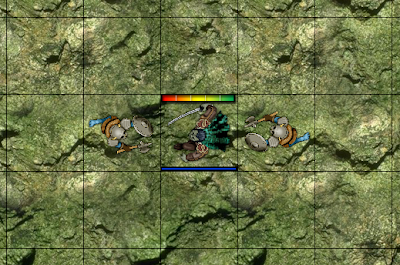DnD combat plays very much like a tactical war game and, as in many tactical games, flanking is an important concept. In the real world this is a tactic where you attack a foe from several directions so that he or she can not effectively defend. While distracted or busy parrying an attack from the front the combatant can easily be cut down from the side or rear by an unseen opponent.
So how was flanking implemented in DnD 4e? Well, take a look at the picture below and consider if the defender (with a green cloak in the centre) might be suffering unseen attacks and struggle to parry attacks from multiple directions. Has the defender been flanked in this example?
In DnD, the answer is no - this is not a flanking situation. The defender gets full defences against all the attackers and none of the attackers gain Combat Advantage (an important concept in DnD which gives +2 to hit and triggers extra effects from many feats and powers).
To flank in DnD the attackers would have to be on directly opposite sides of the defender. The number of attackers doesn't matter and facing doesn't exist so you can never be behind anybody. The defender effectively has 360 degree vision and can spin around instantly to deflect or dodge every attack.
For what otherwise plays like a tactical war game, this is a somewhat odd design decision in my opinion.
Next, consider the second situation shown below.
Here the attackers have wisely taken positions on opposite sides of their target. Although there is only two of them to worry about the defender will now struggle to defend himself or herself, granting combat advantage to both attackers. In the previous example attackers were spread out in the wider 270 degree approach, but the rule set allows only the 180 degree approach to generate advantage seen here.
Not only can the defender no longer spin around to parry, dodge and deflect blows from multiple directions, but there is also no choice to ignore one combatant and focus on defending against the other. Both attackers always gain combat advantage.
This has important implications in fights where there is a great disparity in threat levels between different opponents. No matter how insignificant the threat of the lesser opponent is, as long as it can attack and is in a flanking position you can not ignore it and focus on the more dangerous opponent.
Note that this also holds true even if the lesser combatant is actually fighting somebody else than the flanked defender. Position and capability are required, but actual action is not needed.
If DnD wants to embrace tactical game play the designers would do well to consider adding facing in the next edition, with the associated rules for real flank and rear attacks. Combining this with reasonable rules for parrying and shields would address the inconsistencies and counter-intuitive situations as well as let players make critical decisions about when it is ok to turn your back on a minor threat in order to focus on a greater threat.


No comments:
Post a Comment